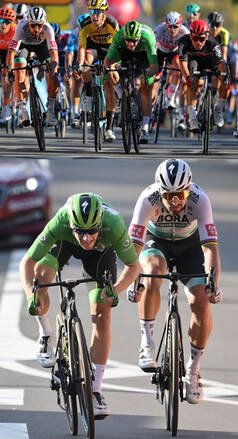
Last Friday was the remaining realistic chance that Peter Sagan had to take back the Green Jersey from Sam Bennett. I say "take back" because Sagan virtually owns the jersey. Since 2012 he has won the jersey every year except for 2017 when he was disqualified for causing a crash. The race organisers also had a hand in the 2020 outcome. While the evidence in this year's race suggests Sagan's speed is not what it was, it is worth remembering that the gap coming into Stage 19 on Friday was almost fully made up of Sagan's relegation from the points in Stage 11 (for bumping).
A thumbnail sketch of some of the key points from Friday's stage illustrate the complexity. Almost from the start, one of Bennett's teammates, Remi Cavanga, went on a breakaway. The commentators speculated that he hoped to get others to follow so as to minimise the points available to Bennett's rivals in the peloton. Nobody went with Cavanga. The commentators expressed surprise at his decision to press on alone for three reasons. First, he was unlikely to make it all the way to the finish alone. Second, he was depriving Bennett of help in the peloton. Third, Cavanga was a potential winner of the following day's time trial (although some thought he might be practicing for it).
After a couple of hours, three other riders set off to bridge the gap to Cavanga. They did not catch him until he had secured the maximum points on the intermediate sprint. However, they did collect the points available for second, third and fourth. Bennett got fifth and Sagan sixth as the sprinters broke from the peloton to contest the remaining points. Then things started to get messy as small groups attempted breakaways. Soon the four leaders were caught and the attacks continued. Then, a group containing Bennett and Sagan broke away with 25km to go. At this stage, Bennett was contributing to the breakaway as much as Sagan. The commentators explained that while Bennett knows that the remainder of the breakaway group will try to dump him before the end, the commentators also suggested that he will be attacked more relentlessly if he does not contribute. Initially it seems that the peloton gives chase. But then they stop. The winner will now come from the breakaway. The unity of the effort to breakaway is now diminished. The coalition starts to fragment.
At this stage Bennett decides to track Sagan. He knows he can beat him in a sprint finish. So he sits on Sagan's rear wheel. Sagan's body language towards Bennett suggests he is not impressed with this tactic. Another rider takes advantage of the breakup of the coalition to launch a successful counterattack. He escapes. Others follow suit but are now only battling for the minor places. Bennett stays with Sagan. Bennett finishes 8th and Sagan 9th. The green jersey is almost secured by Bennett. He proved himself a worth successor to Sagan.
"Friends for (almost) a day" attempts to put some structure on our thinking about such complex and dynamic situations. It is not easy. For example, it needs to define what constituted a breakaway. It decided that a breakaway would need to be away from the peloton for 30km. On Friday, Cavanga was away for more than 30km but the break that happened with 25km to go would not be classified as a breakaway. The authors acknowldge the somewhat abitrary nature of their definition. There is also a problem with the authors' attempt to explain the failure in terms of the public good free-rider. Cavanga's breakaway failed but as he was alone it would be difficult to explain the failure in terms of free-riding. Despite these limitation, the paper does provide statistical support for the economic theory on group sizes. Initially, as the group size increases then the chances of success increases. The effort to breakaway can be reduced by being shared. However, as group size increases then this impact declines and turns negative.
The paper also shows that breakaways are likely to stay away on hilly or mountain stages compared to flat stages. Maybe the authors will examine the potential reasons for this in the future research they promise.
When it comes to empirically evaluating strategic decisions using sports data, it would be fair to say that economists have zoned in on the penalty kick in soccer. It is neater than most strategic situations. Even here researchers simplify by giving the kicker and keeper only two options. By contrast, the authors of "Friends for (almost) a day" have attempted to quantity and explain a richer strategic setting. And, despite the difficulties, they've done a pretty good job of it.
 RSS Feed
RSS Feed